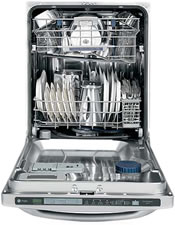Design Considerations for a Kitchen Dishwasher

Tradition has placed the dishwasher right next to the sink. However, times have changed and that isn't as necessary as it once was. The dishwasher went next to the sink because the dishes were scraped and rinsed before putting them in the dishwasher. However, modern dishwashers don't require dishes to be rinsed first and some models really don't even need them to be scraped. If dishes can go straight from the stove or table, right into the dishwasher, there might be a more convenient place to locate the dishwasher.
Another reason the dishwasher was next to the sink was that it simplified the plumbing. The dishwasher got water from the same pipes as the kitchen sink and the dishwasher also shared the drain. However, as long as a water line and waste line can be plumbed in, a dishwasher can go just about anywhere.
The placement of a dishwasher also might take into consideration where the clean dishes get put away. Instead of carrying dishes to the sink, then to dishwasher, then from the dishwasher across the kitchen to the cabinets, maybe some steps can be saved. The sink step might be skipped and the dishwasher located nearer the cabinet.
Practically speaking, most people are going to scrape the dishes. Unfinished plates of spaghetti just seem like too much to expect from a dishwasher to clean. So instead of locating the dishwasher next to the sink, locate a pull out trash bin next to the dishwasher. The dishes can be scraped into the trash and then loaded in to the dishwasher. Another benefit of this layout is it makes it easier for two people to work in the kitchen at one time. One person can load and unload the dishwasher while another has full access to the sink.
Work Triangle
When laying out your kitchen you should create a work triangle, a straight line relationship between the three most used work areas in the kitchen. The stove, the sink or prep area and the refrigerator are the three locations you will spend the most time walking between. Minimizing the numbers of steps and the number of obstacles will go a long way toward making your kitchen a comfortable place to work. Because the triangle relates to food preparation and cooking; the dishwasher really doesn't a play part in this stage and so isn't usually considered when developing the work triangle.
Do I Need a Second Dishwasher?
More kitchens than ever are sporting a second dishwasher. Large families and people who entertain frequently, find them essential. While it might seem a luxury, if you can spare the space, it is certainly worth your consideration. A second dishwasher doesn't have to be a full sized unit, a smaller 18" model could be used, or dishwasher drawers are a possibility. A second dishwasher could be dedicated to glassware and located near that storage cabinet. A second dishwasher might not even be placed in the kitchen, if you have butler's pantry, wet bar, wine serving area or even a family room, a dishwasher in that location could be a great convenience.
Blending Appliances with Cabinetry
Appliances can be made less obtrusive by blending them into the cabinetry with cabinet panels. Many manufacturers offer appliances that will accept a custom panel allowing the appliance to look just like another cabinet door. The panel is provided by your cabinet manufacturer and should be ordered at the same time your cabinets are ordered. A feature called "integrated controls" place the controls out of sight on the top of the door. This further enhances the look of the dishwasher, allowing the door panel cover the entire face of the appliance.
The specifications for the door panel dimensions are supplied by the appliance manufacturer, therefore it is important to select your appliances before you order your cabinets. Your overall kitchen layout may also be affected by the requirements of your appliances. You should take into account clearance specifications, plumbing, venting and electrical requirements of the appliances before finalizing a design.





